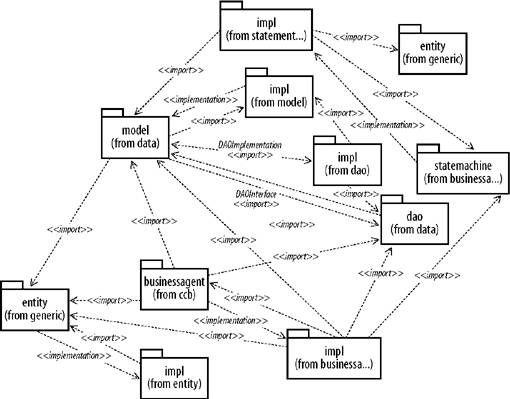Section 12.3. One DiagramOne Abstraction
12.3. One Diagram/One AbstractionEarlier, in Figures 12-2 and 12-3, we separated structure from inheritance. Each diagram contains fewer elements than the all-encompassing diagram shown in Figure 12-1, or even the more modest one shown in Figure 12-2, so they are easier to understand. Figure 12-7 shows package dependencies. The diagram records both the import graph and code generation directives. The superimposition of these two roles results in a diagram with pairs of opposing dependencies between elements. Don't worry if you don't quite understand its meaning; we'll clean it up in a moment. Figure 12-7 fails as a diagram for several reasons. Most strikingly, you don't know where to start: the diagram has no center of gravity. This leads to a lack of flow or direction; do you read the diagram left to right, top to bottom, or inside out? The apparently cyclic dependencies confound any sense of direction. Although opaque to the initiated, the problem with Figure 12-7 stems from trying to use one diagram for two related but different ends: controlling imports and directing code generation. Figure 12-7. Package diagram controlling imports and code generation directives Figure 12-8 addresses the issue of imports only. Elements higher in the diagram depend on elements below. No cycles exist. You can absorb the meaning of the diagram quickly. Removing the imports from Figure 12-7 simplifies it more than you might imagine. Instead of forming a graph like the imports, the directives, as shown in Figure 12-9, just link separate elements with target packages. The noise of the import graph complicated a simple picture. The complicated, large diagram becomes a small diagram of four separate sections. |
EAN: 2147483647
Pages: 132